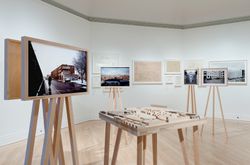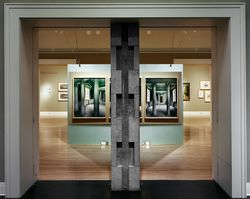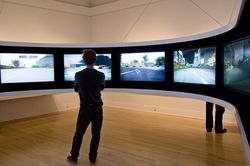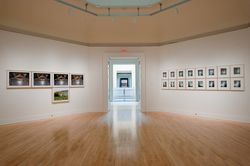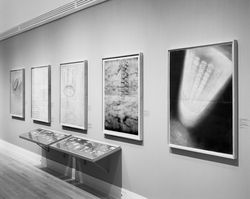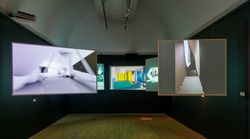Wohnhaus Schlesisches Tor—also known as Bonjour Tristesse—in Berlin and Punt en Komma in The Hague are Álvaro Siza’s first built works outside his native Portugal. The two projects resemble one another in size, scale, program, and ambition: both were built in the 1980s, both are results of a distinct attitude towards the city, and both were social housing projects(...)
Octagonal gallery Keyword(s):
Álvaro Siza, Punt en Komma, The Hague, Bonjour Tristesse, Berlin
24 September 2015 to 22 May 2016
Corner, Block, Neighbourhood, Cities. Álvaro Siza in Berlin and The Hague
Actions:
Description:
Wohnhaus Schlesisches Tor—also known as Bonjour Tristesse—in Berlin and Punt en Komma in The Hague are Álvaro Siza’s first built works outside his native Portugal. The two projects resemble one another in size, scale, program, and ambition: both were built in the 1980s, both are results of a distinct attitude towards the city, and both were social housing projects(...)
Octagonal gallery Keyword(s):
Álvaro Siza, Punt en Komma, The Hague, Bonjour Tristesse, Berlin
Just as Andrea Palladio’s Villa Rotonda helped to define for future generations the architecture of the Renaissance in Italy, so Chiswick is the locus classicus of the Palladian Revival of the eighteenth century. This exhibition follows a major architect’s thinking as he worked from source to design, from design to representation, in the making of a building which, as the(...)
Main galleries
19 July 1994 to 25 September 1994
The Palladian Revival: Lord Burlington, His Villa and Garden at Chiswick
Actions:
Description:
Just as Andrea Palladio’s Villa Rotonda helped to define for future generations the architecture of the Renaissance in Italy, so Chiswick is the locus classicus of the Palladian Revival of the eighteenth century. This exhibition follows a major architect’s thinking as he worked from source to design, from design to representation, in the making of a building which, as the(...)
Main galleries
Project
AP075.S1.1965.PR01
Description:
This project series documents Cornelia Hahn Oberlander's landscape project for the outdoor playground of the Children's Creative Centre. The Centre was part of the Canadian Federal Pavilion built for the Universal and International Exposition of 1967 (Expo 67), located at the south end of Notre-Dame Island in Montréal. Oberlander worked on this project from 1965-1966. She based her design on children's spontaneous exploration, to encourage self-motivation and creative play. The playground included a rolling terrain, looping paths, a wobble walk made of short logs embeded in the ground, a canal, and "giant wooden building pieces and a rocking boat in water replaced static sculptures". [1] The playground included a sand beach-like area with drifwood and plants to be used as play props. At the centre of the playground was a grass mound with an interior cave and a high wooden platform only reachable by a commando rope. A forty-foot long circulating water channel was situated in the east section of the playground and included two small islands linked by bridges, but was narrow enough to allow children to jump over it. The project series contains sketches, preliminary landscape concept plans, site plans, general landscape plans at different stages of design development, several sections and detail drawings for the playground's equipment and installations, and presentation drawings, including perspective views. The project series also contains architectural, electrical, and structural drawings of the Pavilion, which were provided to Oberlander for reference. Also included are photographs of the playground, research material on playgrounds, and articles and publications on the project, including Oberlander's writings, and publications on Expo '67. Source: [1] Herrington, Susan. Cornelia Hahn Oberlander: Making the Modern Landscape, University of Virginia Press, 2014, 304 pages. p. 106.
1965-1971
Children's Creative Centre Playground, Canadian Federal Pavilion, Expo '67, Montréal, Québec (1965-1967)
Actions:
AP075.S1.1965.PR01
Description:
This project series documents Cornelia Hahn Oberlander's landscape project for the outdoor playground of the Children's Creative Centre. The Centre was part of the Canadian Federal Pavilion built for the Universal and International Exposition of 1967 (Expo 67), located at the south end of Notre-Dame Island in Montréal. Oberlander worked on this project from 1965-1966. She based her design on children's spontaneous exploration, to encourage self-motivation and creative play. The playground included a rolling terrain, looping paths, a wobble walk made of short logs embeded in the ground, a canal, and "giant wooden building pieces and a rocking boat in water replaced static sculptures". [1] The playground included a sand beach-like area with drifwood and plants to be used as play props. At the centre of the playground was a grass mound with an interior cave and a high wooden platform only reachable by a commando rope. A forty-foot long circulating water channel was situated in the east section of the playground and included two small islands linked by bridges, but was narrow enough to allow children to jump over it. The project series contains sketches, preliminary landscape concept plans, site plans, general landscape plans at different stages of design development, several sections and detail drawings for the playground's equipment and installations, and presentation drawings, including perspective views. The project series also contains architectural, electrical, and structural drawings of the Pavilion, which were provided to Oberlander for reference. Also included are photographs of the playground, research material on playgrounds, and articles and publications on the project, including Oberlander's writings, and publications on Expo '67. Source: [1] Herrington, Susan. Cornelia Hahn Oberlander: Making the Modern Landscape, University of Virginia Press, 2014, 304 pages. p. 106.
Project
1965-1971
Speed Limits
Speed Limits addresses the pivotal role played by speed in modern life: from art to architecture and urbanism to graphics and design to economics to the material culture of the eras of industry and information. It marks the centenary of the foundation of the Italian Futurist movement, whose inaugural manifesto famously proclaimed “that the world’s magnificence has been(...)
Main galleries
20 May 2009 to 8 November 2009
Speed Limits
Actions:
Description:
Speed Limits addresses the pivotal role played by speed in modern life: from art to architecture and urbanism to graphics and design to economics to the material culture of the eras of industry and information. It marks the centenary of the foundation of the Italian Futurist movement, whose inaugural manifesto famously proclaimed “that the world’s magnificence has been(...)
Main galleries
This exhibition features Italian photographer Guido Guidis photographs of the Brion family mausoleum in Italy, considered to be architect Carlo Scarpa’s masterpiece. The artist’s 54 colour photographs reveal the beauty of the funerary complex, its clean architectural lines, and the poetic nature of Scarpa’s work. By concentrating on particular architectural features,(...)
Octagonal gallery
11 September 2009 to 10 January 2010
Carlo Scarpa's Tomba Brion: Photographs by Guido Guidi, 1997-2007
Actions:
Description:
This exhibition features Italian photographer Guido Guidis photographs of the Brion family mausoleum in Italy, considered to be architect Carlo Scarpa’s masterpiece. The artist’s 54 colour photographs reveal the beauty of the funerary complex, its clean architectural lines, and the poetic nature of Scarpa’s work. By concentrating on particular architectural features,(...)
Octagonal gallery
The exhibition explores one of the most adventurous and influential moments in the history of architecture: the explosion of invention and ideas that followed the October Revolution in Russia. The Soviet avant-garde architects were productivist as much as aesthetic in their concerns; they saw architecture and the arts as one, and they were committed to bringing design(...)
Main galleries
19 June 1991 to 8 September 1991
Architectural Drawings of the Russian Avant-Garde, 1917-1935
Actions:
Description:
The exhibition explores one of the most adventurous and influential moments in the history of architecture: the explosion of invention and ideas that followed the October Revolution in Russia. The Soviet avant-garde architects were productivist as much as aesthetic in their concerns; they saw architecture and the arts as one, and they were committed to bringing design(...)
Main galleries
Celebrating the opening of the CCAs new building, Canadian Centre for Architecture: Building and Gardens reveals the potential of a museum of architecture as a statement: about the nature of the works it collects and exhibits; about its role in the life of a culture or a city; and about architecture itself. Both the restoration of the nineteenth-century Shaughnessy House(...)
Octagonal gallery
7 May 1989 to 25 March 1990
Canadian Centre for Architecture: Building and Gardens
Actions:
Description:
Celebrating the opening of the CCAs new building, Canadian Centre for Architecture: Building and Gardens reveals the potential of a museum of architecture as a statement: about the nature of the works it collects and exhibits; about its role in the life of a culture or a city; and about architecture itself. Both the restoration of the nineteenth-century Shaughnessy House(...)
Octagonal gallery
The exhibition addresses a central and timely aspect of the work of Carlo Scarpa: its distinctive approach to contending with the layers of history that mark the fabric of a city and a building. In addressing Scarpa’s ability to weave new work into, and often out of, the disparate fragments of the old, Carlo Scarpa, Architect: Intervening with History begins to unravel(...)
Main galleries
26 May 1999 to 31 October 1999
Carlo Scarpa, Architect: Intervening with History
Actions:
Description:
The exhibition addresses a central and timely aspect of the work of Carlo Scarpa: its distinctive approach to contending with the layers of history that mark the fabric of a city and a building. In addressing Scarpa’s ability to weave new work into, and often out of, the disparate fragments of the old, Carlo Scarpa, Architect: Intervening with History begins to unravel(...)
Main galleries
drawings
Dessin préliminaires
ARCH7773
Description:
Dessin préliminaires : croquis de plans comparatifs d'hôpitaux et institutions d'enseignement montréalais. Dessins de développement du design : plan de creusage pour le grand perron de l'aile L; plan de l'entrée et élévation de la partie supérieure de l'aile D', 1929 et 1931; plan détaillé de l'étage E'4 et H'4; plans de finition d'un plancher; plan d'étage non-identifié comprenant un bureau de médecin; plan électrique non identifié. Dessins d'exécution préliminaires : détails de la couverture des gaines de ventilation ailes D et D'; modifications au plan des ailes K et L, 1928; détails de portes temporaires dans l'aile B' pour le compte de l'exposition de l'artisanat, 1941; plan et coupe de la salle de l'incinérateur et de la " sorting room ", détails de plinthes et marches pour des corridors et des escaliers, détails de portes intérieures en chêne. Détails des fenêtres à battants en acier, 11 mars 1931 / Cresswell Pomeroy Ltd., Montréal. Plan clef du pavillon principal (dessin 1) / Wallace Sandstone Quarries, Philipsburg, Québec. Lambrissage du mur postérieur de la salle des promotions, 20 avril 1934 /[M. Prévost?]. Nivellement de la terrasse no. 2 et des cours anglaises ailes A et A', plans du mur de soutènement et de la " maison de Monseigneur ", 1931 / M. Aubert.
1924 - 1947
Dessin préliminaires
Actions:
ARCH7773
Description:
Dessin préliminaires : croquis de plans comparatifs d'hôpitaux et institutions d'enseignement montréalais. Dessins de développement du design : plan de creusage pour le grand perron de l'aile L; plan de l'entrée et élévation de la partie supérieure de l'aile D', 1929 et 1931; plan détaillé de l'étage E'4 et H'4; plans de finition d'un plancher; plan d'étage non-identifié comprenant un bureau de médecin; plan électrique non identifié. Dessins d'exécution préliminaires : détails de la couverture des gaines de ventilation ailes D et D'; modifications au plan des ailes K et L, 1928; détails de portes temporaires dans l'aile B' pour le compte de l'exposition de l'artisanat, 1941; plan et coupe de la salle de l'incinérateur et de la " sorting room ", détails de plinthes et marches pour des corridors et des escaliers, détails de portes intérieures en chêne. Détails des fenêtres à battants en acier, 11 mars 1931 / Cresswell Pomeroy Ltd., Montréal. Plan clef du pavillon principal (dessin 1) / Wallace Sandstone Quarries, Philipsburg, Québec. Lambrissage du mur postérieur de la salle des promotions, 20 avril 1934 /[M. Prévost?]. Nivellement de la terrasse no. 2 et des cours anglaises ailes A et A', plans du mur de soutènement et de la " maison de Monseigneur ", 1931 / M. Aubert.
drawings
1924 - 1947
Archaeology of the Digital: Complexity and Convention is the third exhibition related to the development of a strategy for collecting and preserving digital archives at the CCA. The Archaeology of the Digital program comprises twenty-five projects for which digital materials are integral to an understanding of the design process. For projects included in the first two(...)
11 May 2016 to 16 October 2016
Archaeology of the Digital: Complexity and Convention
Actions:
Description:
Archaeology of the Digital: Complexity and Convention is the third exhibition related to the development of a strategy for collecting and preserving digital archives at the CCA. The Archaeology of the Digital program comprises twenty-five projects for which digital materials are integral to an understanding of the design process. For projects included in the first two(...)
